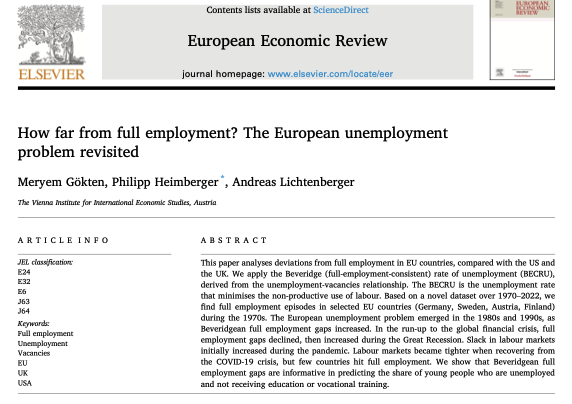Die Einigung zum "EU-Wiederaufbaufonds" ist in zentralen Aspekten bahnbrechend und wird zur Erholung in schwer getroffenen Ländern beitragen, aber sie hat einen hohen politischen Preis. Meine Einschätzung ist heute bei @FESonline erschienen. Ein Thread /1
fes.de/progressive-wi…
fes.de/progressive-wi…

Vor Corona wäre es sicherlich undenkbar gewesen, dass die EU in dieser Dimension zusätzliche Schulden auf der Grundlage von Garantien der Mitgliedstaaten aufnimmt, um temporär zusätzliche EU-Ausgabenprogramme zur Bekämpfung einer Wirtschaftskrise zu lancieren. /2
Zum ersten Mal wird ein EU-weites „sicheres Asset“ geschaffen, welches es Anleger_innen ermöglicht, die unterschiedlich risikobehafteten Anleihen der EU-Mitgliedstaaten zu vermeiden und direkt in EU-Anleihen zu investieren. /3
Das Begeben gemeinsamer Anleihen und die Einführung neuer Eigenmittel sind Elemente einer gemeinsamen europäischen Fiskalpolitik. Mit der Einigung über EU-Wiederaufbaufonds gibt es ein temporäres Element einer gemeinsamen Fiskalpolitik zur Bekämpfung der Corona-Krise. /4
30 Prozent der abrufbaren Gelder im EU-Wiederaufbaufonds müssen im Sinne der „grünen und digitalen Transformation“ eingesetzt werden. Konnex zur längerfristig ausgerichteten politischen Agenda (Green Deal und Digitalisierung) - erheblicher Interpretationsspielraum bleibt /5.
Auch wenn also Aspekte der Einigung vom Juli-Gipfel als positiv gesehen werden können und auch neue Möglichkeiten für die Zukunft des europäischen Integrationsprozesses eröffnen, muss darauf hingewiesen werden, dass dies nicht die bestmögliche Vereinbarung ist. /6
Erstens hätte das Volumen der Zuschüsse höher sein können, um eine größere makroökonomische Wirkung in den von der Pandemie besonders hart betroffenen Ländern zu gewährleisten. Dies wurde durch das Bündnis der sogenannten "sparsamen" Staaten verhindert. /7
Zweitens schafft die sogenannte "Super-Notbremse" eine komplexe und belastende Governance-Struktur, die den Prozess der Auszahlung von Geldern aus dem EU-Wiederaufbaufonds verlangsamen und politische Konflikte zwischen den Mitgliedstaaten verschärfen könnte. /8
Drittens hätte Konditionalität im Hinblick auf Einhaltung der Rechtsstaatlichkeit stärker sein können. Um die osteuropäischen Mitgliedstaaten für eine Einigung ins Boot zu holen, wurde der Konnex zwischen den rechtsstaatlichen Prinzipien und dem EU-Budget aufgeweicht. /9
Viertens stellen höhere EU-Budgetrabatte für einige reiche Länder eine zusätzliche Belastung für die Länder dar, die stattdessen diese Beiträge zahlen müssen. Ursprünglich wollte die Europäische Kommission das Rabattsystem abschaffen, "sparsame Vier" haben es verstärkt. /10
Fünftens wurde mit dem Gipfelabkommen die Gelegenheit verpasst, die EU-Haushaltsstruktur zu modernisieren. Durch den Druck der "sparsamen Vier" kam es zu Kürzungen in den Bereichen Forschung, Gesundheit und "Just Transition" im Kampf gegen den Klimawandel. /11
Die Einigung vom Juli-Gipfel der Staats- und Regierungschefs/-chefinnen ist in Summe gemischt einzuschätzen. Obwohl "sparsame Vier" das Volumen der Zuschüsse reduzierten, bekommen Eurozone und EU nun eine temporäre Version eines makroökonomischen Stabilisierungsinstruments. /12
Für die Zukunft wäre es wichtig, das strikte Nettozahlerdenken bei der Diskussion über das EU-Budget zurückzudrängen und sich stärker auf die Erhöhung des EU-Mehrwerts der EU-Ausgaben zu konzentrieren. /13
Das Europäische Parlament - mit Vetomacht über den EU-Haushalt - akzeptiert die Einigung in der vorliegenden Form nicht, große Änderungen nicht zu erwarten. Zeitplan ist eng; nationale Parlamente müssen dem Abkommen ebenfalls zustimmen, bevor es in Kraft treten kann. /Ende
• • •
Missing some Tweet in this thread? You can try to
force a refresh






















